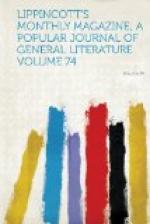“Professor Nichols does not mention morocco in his tables of analyses. Indeed, morocco was so little used for bookbindings until within about thirty years that it affords a less ample field for investigation than any other of the leathers now in common use. My attention was therefore directed specially to this material, of which I found some specimens having a record of nearly fifty years. My observation was, that in all the libraries these were less affected by decay, in proportion to their age, than other leathers. In Harvard College Library the best Turkey morocco, with forty years of exposure, showed no injury except from chafing. The outer integument was often worn away, exposing the texture of the skin, which was still of strong fibre. In the Athenaeum, on the contrary, many of the moroccos showed the same decay as the calf, russia and sheep. There was, however, a wide difference in the condition of moroccos of the same age—some showing as much decay as the calf, while others had scarcely any of the disintegration common to the older calf bindings. The same might, indeed, be said of all leathers, those tanned by the quick modern methods, with much more acid than is used in old processes, in which time is a large factor, showing always a more rapid deterioration. But, the methods being the same, morocco, the oiliest of the common leathers and the one having the firmest cuticle, endures the best.
“The order of endurance of leather (as observed by librarians) against atmospheric effects is as follows, descending from the first to the last in order: Parchment, light-colored morocco, sheep, russia, calf. Cloth wears out quickly by use, but appears—the linen especially—to be affected by the atmosphere only in loss of color. These observations all refer to the ordinary humidity of the air in frequented rooms.
“This, then, is the result of my inquiries: I found the shrinking and breaking resulting from heat much the same in all the libraries, but most in that where the heating is from the outer air brought in over hot-water pipes, the two other libraries examined being warmed by steam-pipes having a higher temperature. I found the mealy structure—or instead thereof flakiness—to prevail most in the Athenaeum, next in the Public Library: in the latter, however, many volumes have been rebound, thus raising the average of condition. In the Harvard College Library no gas—in fact, little if any artificial light—is used, and here, too, the mealy structure and disintegration are mostly absent. I conclude, therefore, from these limited observations, that heat is responsible for a large part of the damage to leather bindings, its effects being evidently supplemented and hastened by gas-combustion.
“The ventilating lamps before described, though rather cumbrous to eyes accustomed to the small and simple apparatus commonly used, might prove valuable in rooms containing fabrics liable; to be injured by the gases from open burners.”




